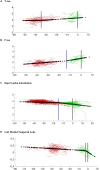Identifying Changepoints in Biomarkers During the Preclinical Phase of Alzheimer's Disease
- PMID: 31001108
- PMCID: PMC6454004
- DOI: 10.3389/fnagi.2019.00074
Identifying Changepoints in Biomarkers During the Preclinical Phase of Alzheimer's Disease
Abstract
Objective: Several models have been proposed for the evolution of Alzheimer's disease (AD) biomarkers. The aim of this study was to identify changepoints in a range of biomarkers during the preclinical phase of AD. Methods: We examined nine measures based on cerebrospinal fluid (CSF), magnetic resonance imaging (MRI) and cognitive testing, obtained from 306 cognitively normal individuals, a subset of whom subsequently progressed to the symptomatic phase of AD. A changepoint model was used to determine which of the measures had a significant change in slope in relation to clinical symptom onset. Results: All nine measures had significant changepoints, all of which preceded symptom onset, however, the timing of these changepoints varied considerably. A single measure, CSF t-tau, had an early changepoint (34 years prior to symptom onset). A group of measures, including the remaining CSF measures (CSF Abeta and phosphorylated tau) and all cognitive tests had changepoints 10-15 years prior to symptom onset. A second group is formed by medial temporal lobe shape composite measures, with a 6-year time difference between the right and left side (respectively nine and 3 years prior to symptom onset). Conclusion: These findings highlight the long period of time prior to symptom onset during which AD pathology is accumulating in the brain. There are several significant findings, including the early changes in cognition and the laterality of the MRI findings. Additional work is needed to clarify their significance.
Keywords: CSF assessment; biomarkers; changepoints; cognitive assessment; preclinical Alzheimer’s disease; shape analysis.
Figures





Similar articles
-
Longitudinal structural cerebral changes related to core CSF biomarkers in preclinical Alzheimer's disease: A study of two independent datasets.Neuroimage Clin. 2018 Apr 16;19:190-201. doi: 10.1016/j.nicl.2018.04.016. eCollection 2018. Neuroimage Clin. 2018. PMID: 30023169 Free PMC article.
-
Relationship between cerebrospinal fluid biomarkers of Alzheimer's disease and cognition in cognitively normal older adults.Neuropsychologia. 2015 Nov;78:63-72. doi: 10.1016/j.neuropsychologia.2015.09.024. Epub 2015 Sep 21. Neuropsychologia. 2015. PMID: 26394023 Free PMC article.
-
Cortical thickness in relation to clinical symptom onset in preclinical AD.Neuroimage Clin. 2016 Jun 15;12:116-22. doi: 10.1016/j.nicl.2016.06.010. eCollection 2016. Neuroimage Clin. 2016. PMID: 27408796 Free PMC article.
-
Simultaneous analysis of cerebrospinal fluid biomarkers using microsphere-based xMAP multiplex technology for early detection of Alzheimer's disease.Methods. 2012 Apr;56(4):484-93. doi: 10.1016/j.ymeth.2012.03.023. Epub 2012 Apr 6. Methods. 2012. PMID: 22503777 Review.
-
Recent advances in cerebrospinal fluid biomarkers for the detection of preclinical Alzheimer's disease.Curr Opin Neurol. 2016 Dec;29(6):749-755. doi: 10.1097/WCO.0000000000000399. Curr Opin Neurol. 2016. PMID: 27805971 Review.
Cited by
-
Amyloid-β Positivity Predicts Cognitive Decline but Cognition Predicts Progression to Amyloid-β Positivity.Biol Psychiatry. 2020 May 1;87(9):819-828. doi: 10.1016/j.biopsych.2019.12.021. Epub 2020 Jan 7. Biol Psychiatry. 2020. PMID: 32067693 Free PMC article.
-
The characteristics of brain atrophy prior to the onset of Alzheimer's disease: a longitudinal study.Front Aging Neurosci. 2024 May 28;16:1344920. doi: 10.3389/fnagi.2024.1344920. eCollection 2024. Front Aging Neurosci. 2024. PMID: 38863784 Free PMC article.
-
Exploring brain health knowledge and practices in young adults in Cuba: Dataset.Data Brief. 2025 Mar 17;60:111479. doi: 10.1016/j.dib.2025.111479. eCollection 2025 Jun. Data Brief. 2025. PMID: 40235695 Free PMC article.
-
A Bayesian semi-parametric model for learning biomarker trajectories and changepoints in the preclinical phase of Alzheimer's disease.Biometrics. 2024 Mar 27;80(2):ujae048. doi: 10.1093/biomtc/ujae048. Biometrics. 2024. PMID: 38775703 Free PMC article.
-
Distributed functional connectivity predicts neuropsychological test performance among older adults.Hum Brain Mapp. 2021 Jul;42(10):3305-3325. doi: 10.1002/hbm.25436. Epub 2021 May 7. Hum Brain Mapp. 2021. PMID: 33960591 Free PMC article.
References
-
- Beg M. F., Miller M. I., Trouv’e A., Younes L. (2005). Computing metrics via geodesics on flows of diffeomorphisms. Int. J. Comp. Vis. 61 139–157. 10.1023/B:VISI.0000043755.93987.aa - DOI
-
- Chang L., Shan D., Wickman J., Holdridge M., Raso C., Wilson D., et al. (2017). “SimoA human neurology 3-plex A (N3PA) immunoassay measures amyloid beta 1-42, amyloid beta 1-40 and tau in blood and CSF samples simultaneously,” in Poster Presented at the Alzheimer’s Association International Conference, Lexington.
Grants and funding
LinkOut - more resources
Full Text Sources

